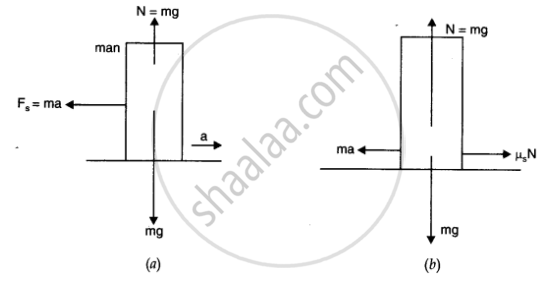Advertisements
Advertisements
Question
Figure shows a man standing stationary with respect to a horizontal conveyor belt that is accelerating with 1 m s–2. What is the net force on the man? If the coefficient of static friction between the man’s shoes and the belt is 0.2, up to what acceleration of the belt can the man continue to be stationary relative to the belt? (Mass of the man = 65 kg.)

Solution 1
Mass of the man, m = 65 kg
Acceleration of the belt, a = 1 m/s2
Coefficient of static friction, μ = 0.2
The net force F, acting on the man is given by Newton’s second law of motion as:
`F_"net"` = ma = 65 × 1 = 65 N
The man will continue to be stationary with respect to the conveyor belt until the net force on the man is less than or equal to the frictional force fs, exerted by the belt, i.e.,
`F_"net"^' = f_s`
`ma^' = mu mg`
∴a' = 0.2 × 10 = 2 m/s2
Therefore, the maximum acceleration of the belt up to which the man can stand stationary is 2 m/s2.
Solution 2
Here acceleration of conveyor belt a = 1 ms-2, μs= 0.2 and mass of man m = 65 kg. t As the man is in an accelerating frame, he experiences a pseudo force Fs= ma as shown in figure
Hence to maintain his equilibrium, he exerts a force F = – Fs = ma = 65 x 1 = 65 N in forward direction i.e., direction of motion of belt.
∴Net force acting on man = 65 N (forward)
As shown in fig. (b), the man can continue to be stationary with respect to belt, if force of friction
`mu_s N = mu_s mg = ma_"max"`
`a_"max" = mu_s g = 0.2 xx 10 = 2 m s^(-2)`

APPEARS IN
RELATED QUESTIONS
Name the physical quantity which is considered to be a measure of the quantity of motion of a body.
What is the change in momentum of a car weighing 1500 kg when its speed increases from 36 km/h to 72 km/h uniformly ?
A plastic ball and a clay ball of equal masses, travelling in the same direction with equal speeds, strike against a vertical wall. From which ball does the wall receive a greater amount of momentum ?
Name the principle on which a rocket works.
A body of mass 2 kg is at rest. What should be the magnitude of force which will make the body move with a speed of 30 m/s at the end of 1 s ?
State the law of conservation of momentum.
An unloaded truck weighing 2000 kg has a maximum acceleration of 0.5 m/s2. What is the maximum acceleration when it is carrying a load of 2000 kg ?
Why would an aircraft be unable to fly on the moon ?
The rockets work on the principle of conservation of :
Suppose a ball of mass m is thrown vertically upward with an initial speed v, its speed decreases continuously till it becomes zero. Thereafter, the ball begins to fall downward and attains the speed v again before striking the ground. It implies that the magnitude of the initial and final momentums of the ball are the same. Yet, it is not an example of conservation of momentum. Explain why?
